JAMES ALBERIONE
"There must be a foundation, a starting point: the upright person. On it can be formed the good Christian, a child of God."
THE “TWOFOLD” STORY OF A MAN OF GOD
In 1953, at the age of 70 and on the occasion of the fortieth anniversary of his foundation, Fr. Alberione discreetly lifted the veil covering his human-spiritual journey and wrote: “Were he to comply with your request and tell you something of what he still remembers and that you consider useful for the Pauline Family, he would have to recount a twofold story: [first] the story of God’s Mercy so as to sing a marvelous ‘Gloria in excelsis Deo et in terra pax hominibus.’ And then, the humiliating story of his lack of conformity to the overabundance of divine love and [his need] to compose a new and sorrowful ’Miserere’ ‘pro innumerabilibus negligentiis, peccatis et offensionibus.’”
April 4, 1884
The “twofold story” begins in San Lorenzo di Fossano (Cuneo), where James Alberione is born. The Alberione family is guided by his father Michele and lovingly cared for by his mother Teresa Allocco. He has three elder brothers: Giovenale, Francesco, and Giovanni; after James, a sister is born who will die within the year, then comes the youngest brother Tommaso. They are a family of poor peasants, deeply Christian and hard-working. Both parents transmit the faith to their children along with a strong work ethic and an unshakeable trust in Providence.
On April 5, a day after his birth, James is baptized in the chapel dedicated to St. Lawrence.
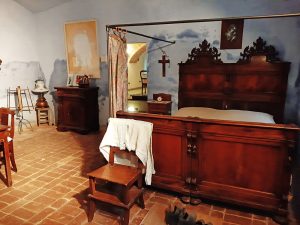
1890
God's plan for James begins to unfold very early on. In first grade, when asked by his teacher Rosa Cardona what he would like to be when he grows up, he responds clearly: “I will become a priest!”
The childhood years that follow are oriented toward this direction.
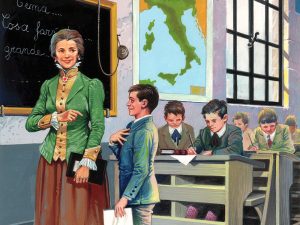
1896 - 1900
In the family home in the region of Cherasco, within St. Martin parish in the diocese of Alba, the parish priest Fr. Montersino helps the adolescent James to become aware of and respond to the Lord’s call.
James spends four school years in the Seminary of Bra, from October 25, 1896 to April 7, 1900, during the second, third, fourth and fifth years of secondary school.
October 1900
At the age of 16 James enters the Seminary of Alba and immediately meets the man who will be his father, guide, friend, and counsellor for 46 years: Canon Francis Chiesa, professor of philosophy and of dogmatic and moral theology.
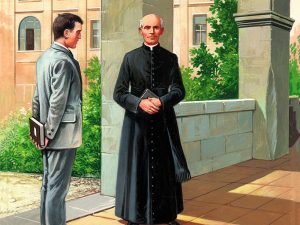
TO DO “SOMETHING” FOR THE LORD AND FOR THE MEN
AND WOMEN OF THE NEW CENTURY
The young priest prays a lot, studies, and volunteers himself for preaching, catechesis, and conferences in parishes throughout the diocese. He also dedicates much time to study, particularly deepening texts that enlighten and update him on the current situation of civil and ecclesial society and on the needs of present-day men and women: where is this humanity heading?
But the Lord wants and guides him toward a new mission, multifaceted in means and structures, to preach the Gospel to all peoples in the spirit of the Apostle St. Paul: to bring people to God and God to people, using modern means of communication. Two books of considerable importance that mature in those years testify to this orientation: Notes on Pastoral Theology (1912) and Woman Associated with Priestly Zeal (begun in 1911 and published in 1915).
Greater light and greater understanding for a new path occurs in 1910, when Fr. Alberione becomes aware that the mission of giving Jesus Christ to the world must be assumed and carried out by consecrated persons: “The works of God are done with the men of God,” he will love to repeat often.
December 31, 1900-January 1, 1901
At the end of the Holy Year 1900, already strongly challenged by Pope Leo XIII's encyclical “Tametsi futura”, James heeds the powerful invitation of divine grace: on the night of December 31, 1900, which divides the two centuries, he remains in adoration for four hours before the Blessed Sacrament solemnly exposed in the Cathedral of Alba. A “particular light,” as he himself testifies, comes to him from the Host, and from that day on he feels “deeply obliged to do something for the Lord and for the men and women of the new century,” “obliged to serve the Church,” with the new means offered by human ingenuity.
As a result of this experience, Fr. Alberione will remind his future sons and daughters without end: “You were born from the Host, from the Tabernacle!”
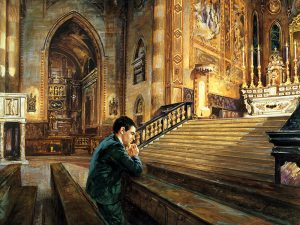
1902-1906
The itinerary of the young Alberione proceeds intensely during the scholastic years of philosophy and theology;
December 8, 1902 marks the date of his clerical vestition.
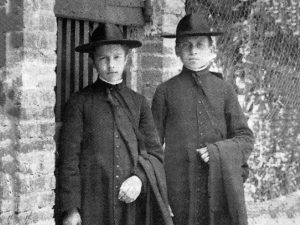
June 29, 1907
On a Saturday, the Feast of the holy Apostles Peter and Paul, James Alberione is ordained a priest, with the sacred order of the Presbyterate at the hands of Bishop Joseph Francis Re.
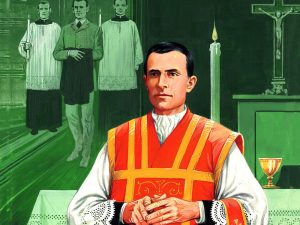
1907 - 1908
In the second year of moral theology (1907–1908), after his ordination to the priesthood, Fr. James Alberione devotes himself particularly to the study of morality in the office of confessor, and pastoral care in the direct care of souls.
This is followed by a brief but decisive pastoral experience in Narzole (Cuneo), in the parish of St. Bernard, as vice parish priest from March 1908 extending for about seven months.
During the few months of direct pastoral apostolate, he meets the young Joseph Giaccardo, who will become for him what Timothy was to the Apostle Paul.
Also while in Narzole, Fr. Alberione develops a greater understanding of what a woman involved in the apostolate can do.
THE MISSION IS REALIZED:
TO EVANGELIZE WITH MODERN MEANS
In obedience to God and the Church, on August 20, 1914, as Pope Pius X dies in Rome, Fr. Alberione begins the “Pauline Family” in Alba with the foundation of the Pious Society of St. Paul. Everything takes place in a simple and unassuming manner: Fr. Alberione feels himself an instrument of God, moved by the divine pedagogy that loves to “always start from a crib,” in silence and hiddenness.
The human family—from which Fr. Alberione draws inspiration—is composed of...brothers and sisters. Fr. Alberione is well aware of the important role that women play in “doing good” for the glory of God and for the salvation of their brothers and sisters. The first woman who follows Fr. Alberione is a twenty-year-old young lady from Castagnito (Cuneo): Teresa Merlo. Slowly but surely, amid difficulties of every kind, the “Family” develops, male and female vocations increase, and the apostolate is delineated and takes shape.
In 1918 (December) the first departure of the “daughters” takes place toward Susa; a courageous story rich in faith and youthful enthusiasm begins, which also generates a characteristic “Pauline style.”
It is quite easy to follow the chronology of these years—but how much progress! God is present and gives clear signs that it is He alone who wants the Pauline Family.
September 8, 1913
On the Feast of the Nativity of the Virgin Mary, the bishop of Alba, Most Rev. J. Francis Re, commissions the priest James Alberione to manage the weekly newspaper of the diocese, the Gazzetta d’Alba.
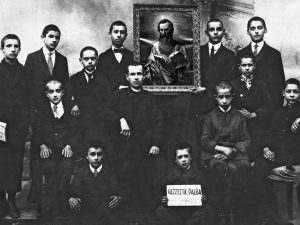
August 20, 1914
The Small Worker's Typographic School is born, nucleus or seed of the future Pious Society of St. Paul , for the apostolate of the press. On March 12, 1927 it will be erected by Bishop Re as a religious congregation of diocesan right.
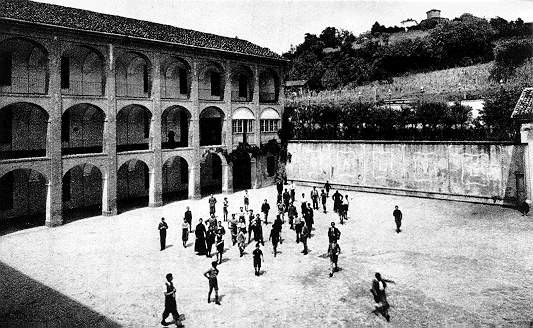
June 15, 1915
With the contribution of Teresa Merlo, Alberione begins the first female community of the future Pious Society of the Daughters of St. Paul .
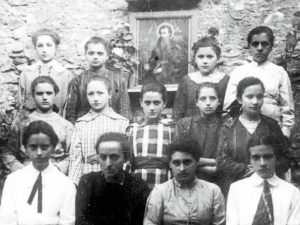
October 25, 1918
The first issue of the publication entitled Unione Cooperatori Buona Stampa is published as the unifying tool between the Pious Society of St. Paul and its Cooperators, and among the Cooperators themselves.
1923
In July 1923 a dark cloud seems to nip all dreams in the bud. Fr. Alberione falls seriously ill, and the doctors’ response offers no hope. But then, contrary to all predictions, Fr. Alberione miraculously resumes course: “Saint Paul healed me,” he will later remark.
February 10, 1924
The second female congregation comes to life: the Pious Disciples of the Divine Master, for the Eucharistic, priestly and liturgical apostolate. Fr. Alberione invites the young Orsola Rivata to guide the young women in their new vocation.
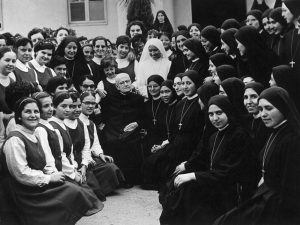
January 1926
The foundation of the first “branch” house in Rome takes place, followed by many foundations in Italy and abroad in the succeeding years.
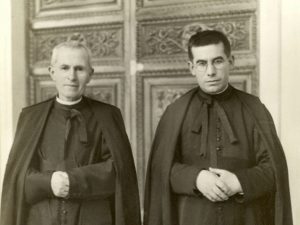
Fr. Alberione, always aflame with “zeal” for souls, identifies the quickest ways to reach every person with the Gospel message, especially persons far away and the masses of people.
Sensing that, in addition to books, the publication of periodicals could be a very effective means, he throws himself extensively into this form of apostolate.
• In 1912, the magazine Vita Pastorale is published for pastors, so that “every pastor may be a Good Shepherd, modeled on Jesus Christ...”;
• Famiglia Cristiana is born in 1932, as a weekly magazine with the aim of nourishing the Christian life of families.
• La Madre di Dio is started in 1932 “to reveal to souls the beauty and grandeur of Mary”;
• Pastor bonus (1937) comes into being as a monthly magazine in Latin, in which Alberione reflects on problems of pastoral care and also offers profound biblical-theological meditation;
• Via, Verità e Vita (1952), is a monthly magazine for the knowledge and instruction of Christian doctrine;
• La Vita in Cristo e nella Chiesa (1952) is a periodical whose purpose is to “make known the treasures of the Liturgy, to promote all that is needed for the Liturgy, to live the Liturgy according to the Church...”.
• Fr. Alberione also considers young people: for them he publishes Il Giornalino in 1924.
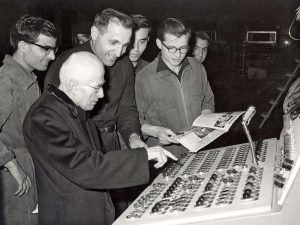
FROM ALBA TO THE WORLD:
LIKE PAUL, ALWAYS ON THE JOURNEY
Intense activity resumes for Fr. Alberione at the end of 1945, with long trips made all around the world to meet and encourage the brothers and sisters. He is “dazzled” by the East (India, China, the Philippines...)—the multitudes, the billions of people...but how many know Jesus Christ? “Strain forward! Do not think about what has been done, but rather about what remains to be done”.
The years 1950–1960 are golden years of consolidation for the Pauline Family: everything flourishes - vocations, foundations, editions, multiple initiatives, commitment to formation, study, and poverty.
Fr. Alberione is now the guide of about ten thousand people, including the Pauline Cooperators—all united by the same ideal of holiness and apostolate: the advent of Christ, Way, Truth, Life, in souls and in the world, through the instruments of social communication.
1931
Only seventeen years after its foundation, in August 1931, Fr Alberione sent the first missionaries out of Italy: Brazil, Argentina, United States.
1934-1935
The second expansion of the Pious Society of St. Paul takes place, with foundations in Spain, Poland, and the Far East of Asia: China, Japan, India and the Philippines.
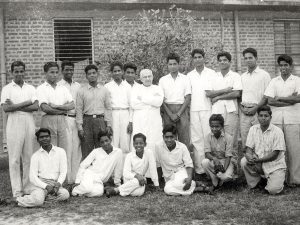
1936
In the month of July, after preaching a course of spiritual exercises, Fr. Alberione goes to reside permanently in Rome, in Via di Grottaperfetta, bringing with him the General Direction of the whole Pauline Family, and a wealth of projects and initiatives.
October 7, 1938
In October 1938 Fr. Alberione founds the third female congregation: the Sisters of Jesus the Good Shepherd or “Pastorelle,” destined for the direct pastoral apostolate in support of pastors.
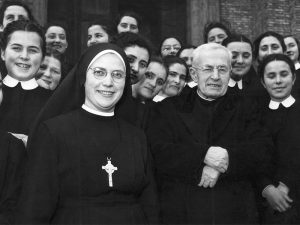
May 13, 1939
“We need to begin the apostolate of the cinema: let us go for an hour of adoration at St. Paul’s tomb,” Fr. Alberione tells some of his collaborators one day, and together they go to the Basilica of St. Paul in Rome.
The Società Anonima Romana Editrice Film (REF)—the first name given to Sampaolo Film—is established to carry out cinematographic activity.
1940-1945
The Second World War (1940–1945) marks a setback; although Primo Maestro is forced to remain in Rome, however, he does not stop in his spiritual journey. While awaiting the return of better working conditions, he continues to welcome the light of God in an increasingly radical way, in climate of adoration and contemplation that grows every day.
The fruit of this adoring attitude is seen in the writings that the Founder continues to give to his children, all of which are of great importance to the Pauline Family. Just by way of reminder, there is the “Via humanitatis” (1947), a highly outstanding rereading of the journey of humanity from a Marian perspective (“per Mariam, in Christo et in Ecclesia”), and his unfinished dream: the Project of an Encyclopedia on Jesus Master (1959).
May 10, 1941
Pius XII grants the Pious Society of St. Paul the Decree of Praise and approvs its Constitutions. On July 12, Fr. Alberione has a private audience with Pius XII. On June 27, 1949, definitive approval is obtained.
December 27, 1945
Fr. Alberione makes his first trip to the United States; on his second trip, in 1949, he passes through India, the Philippines and Japan; in the summer of 1949 he travels to the USA, Mexico, and Canada; in Spring 1952, to the Americas; in Spring 1953 again to the East, as in 1949; in Autumn 1955 back to the East. In 1963–64 he visits Pauline communities in all the continents (including Africa), with the evident intention of giving everyone a final greeting.
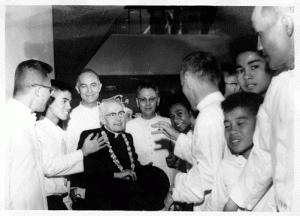
December 1948
The first experimental radio broadcast is made on Christmas Day 1948; at 8:00 a.m. “Radio San Paolo” begins to call listeners previously notified; at 8:10 a.m., a very excited Fr. Alberione sits in front of the microphone and begins to speak.
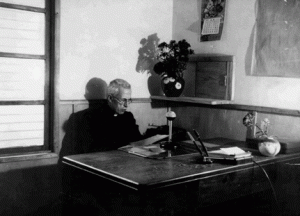
January 15, 1953
Definitive pontifical approval of the Pious Society of the Daughters of St. Paul is granted.
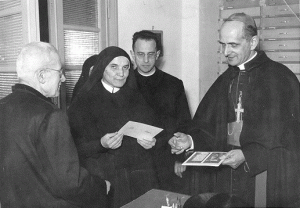
1954
The fortieth anniversary of foundation is celebrated and documented in a volume published for the occasion: Mi protendo in avanti. It is precisely on this occasion that Fr. Alberione manages to overcome his natural reluctance in speaking about himself and hands over to his children the writing that will be published with the title: Abundantes divitiae gratiae suae, which is now considered the “charismatic story of the Pauline Family.”
8 dicembre 1954
The official date of the dedication of the church built in honor of Mary Most Holy, Queen of the Apostles, in fulfilment of the vow made by Fr. James Alberione during the war of 1939–1940.
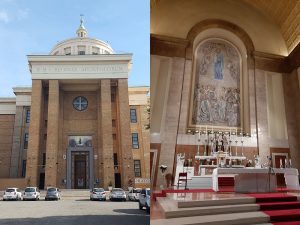
April 1957
The First General Chapter of the Pious Society of St. Paul is held. Fr. Alberione is present at the Chapter and personally directs all the Chapter works.
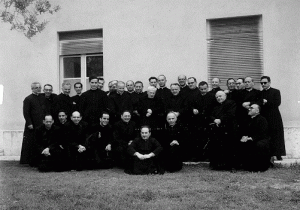
June 29, 1959
The Sisters of Jesus the Good Shepherd are granted first pontifical approval and the Decree of Praise.
September 8, 1959
The Sisters of the Queen of the Apostles , called “Apostoline”, is the last religious Congregation founded by Fr. James Alberione. To them is entrusted a very important mission, especially today, namely, that of focusing on religious, priestly and apostolic vocations.
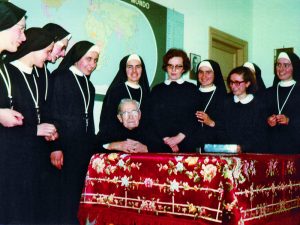
April 8, 1960
Pontifical approval for the three Aggregate Institutes (founded in 1958):
1) Institute of Jesus the Priest, for diocesan priests;
2) Institute of St. Gabriel Archangel, for lay men;
3) Institute of Mary Most Holy of the Annunciation, for lay women.
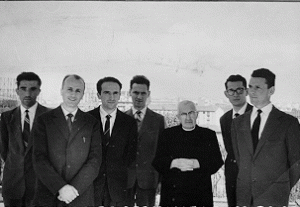
FROM THE CHURCH OF THE COUNCIL
TO THE HEAVENLY ONE
Blessed James Alberione lived for 87 years. In his last hours, he is comforted by the visit and blessing of Pope Paul VI, who never hid his admiration and veneration for Fr. Alberione. On June 28, 1969 (when Fr. Alberione is already 85 years old), Paul VI grants an audience to Primo Maestro and a large representation of members of the Pauline family. This occasion is very dear to the entire family because Pope Paul VI leaves a memorable testimony:
“Here he is: humble, silent, tireless, always vigilant, always collected in his thoughts, running from prayer to work, always intent on scrutinizing the ‘signs of the times,’ that is, the most ingenious ways of reaching souls. Our Fr. Alberione has given the Church new tools to express herself, new means to give vigor and breadth to her apostolate, new capacity and new awareness of the validity and possibility of her mission in the modern world and with modern means. Dear Fr. Alberione, let the Pope enjoy this long, faithful and tireless effort and the fruits produced by it for the glory of God and for the good of the Church.”
On June 25, 1996 the Holy Father John Paul II signs the Decree which recognizes the heroic virtues and the consequent title of Venerable to be attributed to Fr. James Alberione.
Seven years after, in April 27, 2003 at St. Peter's Square, Fr. James Alberione was proclaimed blessed by Pope John Paul II with the exhortation “What a formidable heritage he left his religious family! May his spiritual sons and daughters keep intact the spirit of their origins, to respond adequately to the needs of evangelization in the contemporary world.”
August 30, 1960
Pope John XXIII grants the definitive approval of the Congregation Pious Disciples of the Divine Master and their Constitutions.
1962-1965
The Second Vatican Council takes place. Primo Maestro is a silent but very attentive protagonist during the four “sessions” in which he participates daily with lively commitment. December 4, 1963 is a day of particular jubilation, when the Council Decree Inter Mirifica is issued, with the pronouncement to assume the instruments of social communication as a means of evangelization.
He comments: “Now you can no longer have doubts. The Church has spoken.” And again: “I have given you the best. If I had found something better, I would give it to you now, but I haven’t found anything better.”
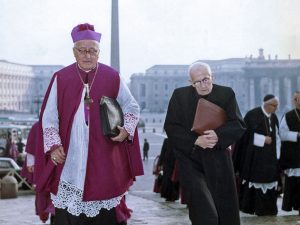
May 3, 1965
Fr. Alberione visits Padre Pio of Pietrelcina in San Giovanni Rotondo (Foggia).
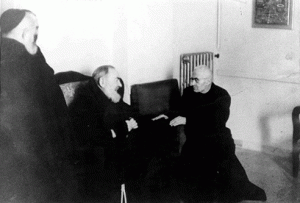
February 10, 1966
Fr. Alberione, man of courageous decision, of foresight, reveals himself as such also in the field of audio recording. On this day, the Studio for voice and music recording is inaugurated, the first phase for the production of records.
April 22, 1969
The Second General Chapter, which is also Special, opens. On August 5, Fr. Alberione is elected Superior General Emeritus. Fr. Luigi Damaso Zanoni succeeds him in the government.
June 28, 1969
Paul VI receives Fr. James Alberione in the Clementine Hall of the Vatican for a special audience. He is accompanied by the Capitulars of the Pious Society of St. Paul and a large representation of the other Congregations and Institutes of the Pauline Family.
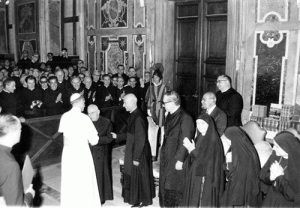
November 26, 1971
Fr. James Alberione dies in the early hours of the evening, at 6:25 p.m. An hour earlier the Holy Father Paul VI visits him in his room in Via Alessandro Severo 58, Rome, kneeling in front of his bed in prayer.
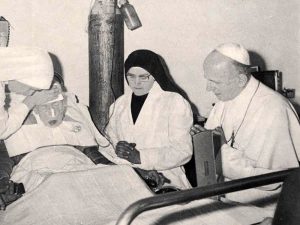
June 19, 1982
The Canonical Process for the cause of beatification opens in Alba, in the temple of St. Paul the Apostle, at 5:00 p.m.
June 25, 1996
John Paul II declares Fr. Alberione “Venerable” because he exercised the theological, cardinal and related theological virtues to a heroic degree.
December 20, 2002
The Holy Father John Paul II, in the presence of the Superiors General of the Pauline Family, reads the Decree for the Beatification of Venerable Fr James Alberione.
April 27, 2003
In St. Peter's Square, at 10:30 a.m., Pope John Paul II inscribes Fr. James Alberione among the Blessed in the Roman martyrology.
